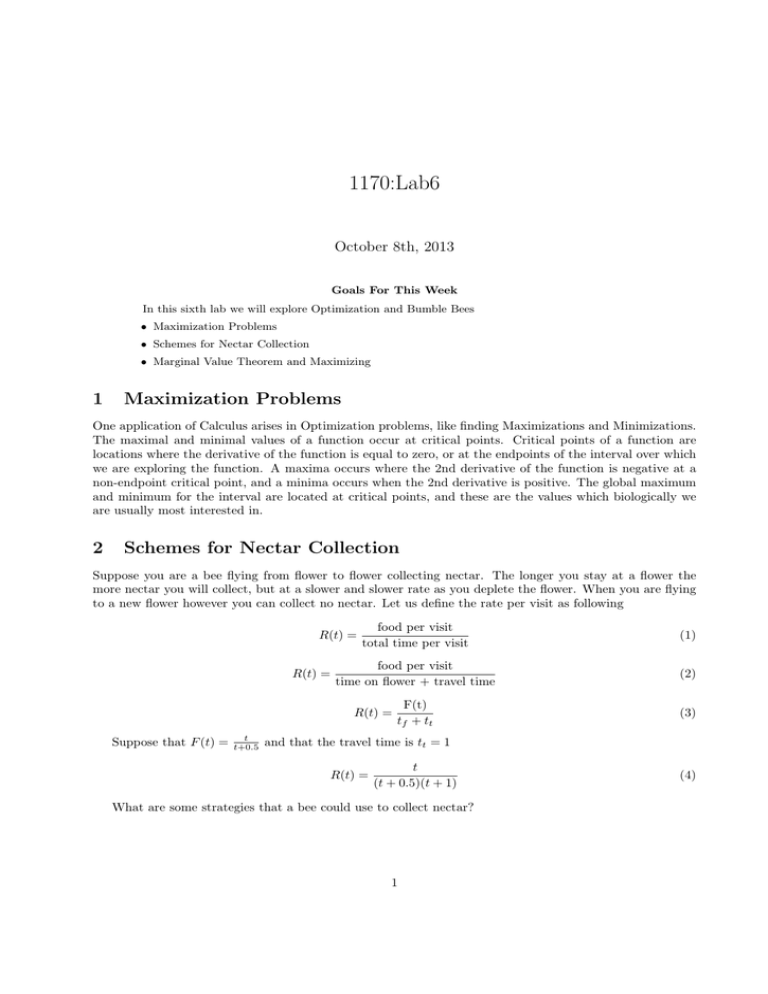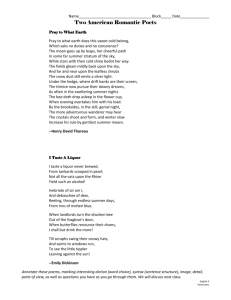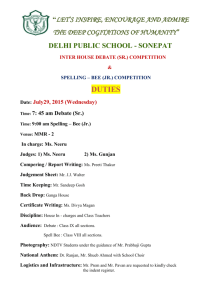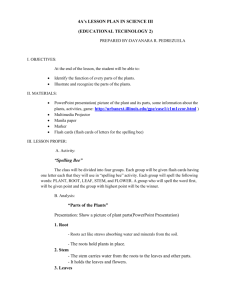1170:Lab6 October 8th, 2013
advertisement

1170:Lab6
October 8th, 2013
Goals For This Week
In this sixth lab we will explore Optimization and Bumble Bees
• Maximization Problems
• Schemes for Nectar Collection
• Marginal Value Theorem and Maximizing
1
Maximization Problems
One application of Calculus arises in Optimization problems, like finding Maximizations and Minimizations.
The maximal and minimal values of a function occur at critical points. Critical points of a function are
locations where the derivative of the function is equal to zero, or at the endpoints of the interval over which
we are exploring the function. A maxima occurs where the 2nd derivative of the function is negative at a
non-endpoint critical point, and a minima occurs when the 2nd derivative is positive. The global maximum
and minimum for the interval are located at critical points, and these are the values which biologically we
are usually most interested in.
2
Schemes for Nectar Collection
Suppose you are a bee flying from flower to flower collecting nectar. The longer you stay at a flower the
more nectar you will collect, but at a slower and slower rate as you deplete the flower. When you are flying
to a new flower however you can collect no nectar. Let us define the rate per visit as following
food per visit
total time per visit
(1)
food per visit
time on flower + travel time
(2)
F(t)
tf + tt
(3)
R(t) =
R(t) =
R(t) =
Suppose that F (t) =
t
t+0.5
and that the travel time is tt = 1
R(t) =
t
(t + 0.5)(t + 1)
What are some strategies that a bee could use to collect nectar?
1
(4)
2.1
Strategy 1
Suppose that a bee spends 5 second collecting nectar before travelling to the next flower.
What is the amount of nectar that the bee has collected as a function of time?
For a single flower and single visit this is equal to F(t)
To visualize this let us enter the following:
t<-seq(0,5,0.01)
F<-function(t){t/(t+.5)}
plot(t,F(t),type=’l’)
for the next second, t=(5,6) there is no nectar collected as the bee is travelling to the next flower.
to plot this piecewise defined function we will need to use some new commands in R.
• The first command is curve(a,b,c) which will plot a function named a from (b,c).
• The second command is the ifelse command, this will allow us to put conditional statements.
For example:
F<-function(t) ifelse(t<=5, t/(t+0.5), 5/5.5)
curve(F,0,6)
t
as long as t <= 5, otherwise it will be defined as
These commands will define as a Function F (t) = t+0.5
5/5.5 which is the value of F(5).
Now the bee will reach another flower an begin harvesting again the bee has collected F (5) = 5/5.5 =
.90909 nectar in 6 seconds which is 0.151515 nectar per second.
2.2
Strategy 2
Now the bee collects nectar for 2 seconds before travelling.
G<-function(t) ifelse(t<=2, t/(t+.5), ifelse(t<=3, 2/2.5, ifelse(t<=5,
+ (t-3)/(t-3+.5)+2/2.5, (5-3)/(5-3+0.5)+2/2.5)))
curve(G,0,6)
Which strategy allows the bee to gather more honey?
Is there a way to figure out what the bee’s best strategy is?
3
Marginal Value Theorem
The Marginal value theorem states that the best strategy is to leave when the instantaneous rate is equal to
the average rate.
F (t)
= R(t)
tf + tt
(5)
d(t+0.5)
(t + 0.5) dt
dt − t
dt
(t + 0.5)2
(6)
(t + 0.5) − t
(t + 0.5)2
(7)
F 0 (t) =
For our problem F (t) =
t
0.5+t
F 0 (t) =
F 0 (t) =
2
therefore
F 0 (t) =
0.5
(t + 0.5)2
Now we want to set this equal to R(t) and solve for t. Where R(t) =
F 0 (t) =
(8)
t
(t+0.5)(t+1)
t
0.5
=
= R(t)
(t + 0.5)2
(t + 0.5)(t + 1)
(9)
0.5(t + 1) = t(t + 0.5)
(10)
t2 = 0.5
(11)
therefore t=0.707 is how long the bee should stay on the flower before leaving.
How much nectar would a bee collect using this strategy over the course of 5 seconds?
H<-function(t){t/(t+0.5)}
H(0.707)
This is how much a bee makes for a single flower, after that they travel for 1 second.
The following is a table of how much the bee makes in total over seconds. Was this strategy more
effective?
time total time nectar total nectar
.707
.707
.586
.586
1
1.707
0
.586
.707
2.414
.586
1.172
1
3.414
0
1.172
.707
4.121
.586
1.758
1
5.121
0
1.758
.707
5.898
.586
2.344
.102
6
0
2.344
4
Assignment for this week
Suppose that our bee finds itself in a less populated flower patch. Now instead of 1 second travel time, it
t
takes the bee 5 seconds to travel between flowers. Assume that F (t) = t+0.5
remains the same.
1. How long should the bee now stay at the flower to maximize its nectar collection (show your work)?
2. Include with your solution a plot of the total nectar collected by the bee as a function of time as it
visits 2 flowers using the commands we learned to plot piecewise defined functions. Hint: The total
time of the plot should be 2 times your solution to the first part plus 5.
3





